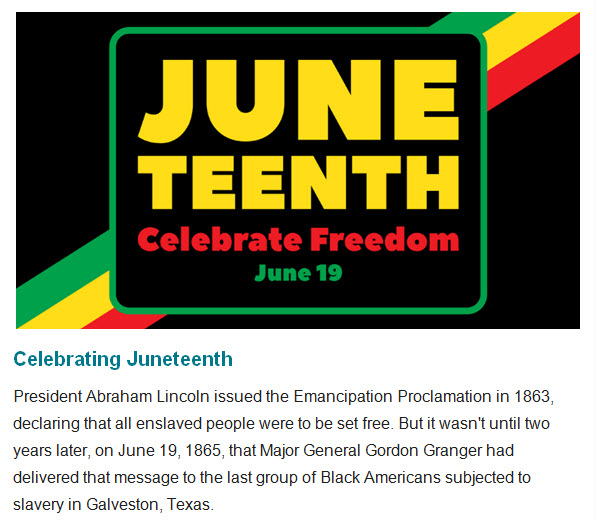File:Juneteenth.jpg
Juneteenth.jpg (596 × 521 pixels, file size: 106 KB, MIME type: image/jpeg)
Juneteenth
"Juneteenth", June 19th...
June 19, 1865... the day Texas heard slavery ended. That day has been recognized — and celebrated — annually as Juneteenth since that’s the day that Union soldiers pulled into Galveston and told all who would listen that the Civil War had ended and enslaved people were free. That’s about two and a half years after Lincoln’s proclamation became law.
In 1863 President Lincoln issued the Emancipation Proclamation declaring “all persons held as slaves within any State, or designated part of a State, the people whereof shall then be in rebellion against the United States, shall be then, thenceforward, and forever free.” Nonetheless, the Emancipation Proclamation did not end slavery in the nation. Lincoln recognized that the Emancipation Proclamation would have to be followed by a constitutional amendment in order to guarantee the abolishment of slavery.
The Thirteenth Amendment to the US Constitution
The 13th amendment, which formally abolished slavery in the United States, passed the Senate on April 8, 1864, and the House on January 31, 1865. On February 1, 1865, President Abraham Lincoln approved the Joint Resolution of Congress submitting the proposed amendment to the state legislatures. The necessary number of states ratified it by December 6, 1865. The 13th amendment to the United States Constitution provides that "Neither slavery nor involuntary servitude, except as a punishment for crime whereof the party shall have been duly convicted, shall exist within the United States, or any place subject to their jurisdiction."
~
File history
Click on a date/time to view the file as it appeared at that time.
| Date/Time | Thumbnail | Dimensions | User | Comment | |
|---|---|---|---|---|---|
| current | 17:55, 20 June 2020 |  | 596 × 521 (106 KB) | Siterunner (talk | contribs) |
You cannot overwrite this file.
File usage
The following page uses this file:
- Affordable Housing
- Bioneers
- City Governments
- City-County Governments
- Civil Liberties
- Civil Rights
- Economic Development
- Economic Justice
- Election System Reform
- Education
- Green Graphics
- Green Politics
- Green Values
- Housing
- Human Rights
- Labor Issues
- New Economy
- Peace
- Planet Citizens
- Resilience
- Social Justice
- Strategic Demands
- US
- Voting Systems
- Whole Earth
- Women's Rights
- Workers Rights
- Youth
